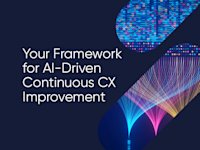The Cobra Effect of CX: Why containment is the wrong metric in AI voice automation
Learn why organizations must escape the containment metric trap when it comes to AI voice automation and AI agents, instead shifting focus to deliveri...
The Team at CallMiner
October 06, 2025


Consumers today demand fast, personalized service on every interaction with a brand, whether it’s a call to support, using a mobile app, or social media chat. Providing those experiences at scale with manual processes alone is nearly impossible.
Customer experience (CX) automation can bridge that gap with AI and analytics technologies that automate the entire customer journey. Predicting customer needs, routing inquiries and personalizing offers are just a few ways CX automation helps organizations provide efficient, consistent, human-centered experiences while managing costs and loyalty.

In this guide, we’ll explain what CX automation is, why it matters now, the core technologies involved, and how to implement and measure it for lasting customer and business impact.
In this article:
CX automation is the application of AI-powered technologies and analytics to orchestrate and optimize the entire end-to-end customer journey, from the first website visit to post-purchase support and beyond. This differs from customer support automation, which is used solely for scripted tasks, such as sending confirmation emails or routing tickets. CX automation is the orchestration of the customer experience across all channels and touchpoints. It’s about real-time adaptation and personalization.
Several key capabilities drive CX automation. Automated workflows help power complex, multi-step processes, such as billing resolutions or service appointments, with minimal human intervention.
Real-time decision-making takes incoming signals (behavioral, sentiment, and past purchase history) and determines the next course of action in the moment. Data-driven personalization surfaces the right messages, offers, and support pathways for individuals, creating a seamless and frictionless experience.
Driving these capabilities is a set of advanced technologies and tools. Artificial intelligence and machine learning algorithms are trained to learn and improve from every interaction and action.
Natural language processing (NLP) helps chatbots and voice assistants understand intent and context. Predictive analytics enables businesses to spot trends, potential churn, or upsell opportunities before the customer has to raise a single finger.
Customer expectations are increasing at a pace that many teams struggle to keep up with. Customers expect an answer in seconds and personalized experiences, regardless of whether they’re messaging support at 2 a.m. or browsing during their lunch hour.
AI and analytics are making that possible. By combing through large volumes of data in real time to understand intent, predict next steps, and route inquiries to the most appropriate channel or agent, they help customers get what they need fast and without having to wait or repeat themselves.
The 2025 CallMiner CX Landscape Report underscores this urgency: 96% of CX and contact center leaders now view AI as a key strategy, with AI adoption climbing to 80%, up from 62% just a year earlier. The study also shows that over half (51%) of organizations rely entirely on third-party AI software, and those choosing vendor solutions are moving faster: 85% have at least partially implemented AI compared to 71% of those building solutions in-house.
CX automation, enabled by AI and analytics, also helps businesses achieve measurable business outcomes. Automated routing and self-service solutions help free agents from repetitive tasks, reducing operating expenses and response times.
Predictive insights can also enable teams to identify and act on churn risks, as well as personalize offers to help drive loyalty and increase customer lifetime value (CLV). The end result is a stronger link between CX and bottom-line results: faster, less expensive service and relationships that stick.
CX automation infuses intelligence and speed into every phase of the customer journey, making interactions more personalized, frictionless, and efficient.
AI and analytics analyze data, such as purchase history, browsing behavior, and service interactions, to create insights that drive each touchpoint. Messages, product recommendations, and offers are delivered at the right time and via the most relevant channel, creating a level of relevance that resonates with customers and fosters loyalty.
Predictive models identify potential issues such as shipping delays or account anomalies before the customer even knows they exist. The team can automatically send alerts, modify orders, or recommend solutions, transforming potential frustration into trust-building moments.
Customers can initiate a query through a mobile app, transition to live chat, or visit a company’s brick-and-mortar location. CX automation ensures context is never lost as they switch between channels. Conversations, preferences, and order information persist across web, social, and in-person engagements, and customers never have to repeat themselves.
Automating routine tasks, such as routing inquiries, processing returns, or answering FAQs, reduces wait times and frees agents to focus on more complex cases. Faster resolutions and smoother processes result in a better experience from start to finish.
CX automation combines several interconnected technologies that enable more seamless, intelligent, and fully connected experiences for customers.
Chatbots handle routine inquiries (e.g., order status, password resets, basic troubleshooting) and route to a human expert when necessary. Available 24/7, chatbots can provide instant assistance, reduce wait times, and free human agents for more complex or high-value tasks.
Real-time decisioning systems intelligently route each interaction to the most appropriate agent or resource, taking into account context, priority, and skill set. Workflow automation reduces friction by automating repetitive tasks, such as creating tickets or scheduling follow-up appointments.
Customer data platforms (CDPs) gather data from websites, apps, call centers, and point-of-sale systems to form a unified customer profile. This single customer view acts as a single source of truth for personalization, marketing, sales, and service teams.
Machine learning algorithms predict outcomes such as churn, repeat purchase intent, and service needs. Prescriptive analytics is the next step in recommendation, providing next-best-action suggestions that are specific and actionable (e.g., a retention offer or product upsell) to improve customer satisfaction and increase revenue.
NLP and speech analytics measure customer sentiment and emotion across voice calls, live chat, and unstructured data (e.g., surveys, social media). Real-time alerts notify agents and managers about deteriorating customer sentiment, allowing them to address issues promptly.
An effective customer experience automation blueprint needs a prioritized roadmap and disciplined execution phases.
Map the full experience journey, including web, mobile, call center, and in-store interactions. Identify friction points such as wait times, repeated questions, and lack of follow-up. Pain points indicate initial automation opportunities where you can add the most value.
Evaluate potential solutions for AI, analytics, and integration capabilities. The 2025 CallMiner CX Landscape report notes that organizations investing in vendor AI solutions are further along in their implementation journeys: 85% have at least partially implemented AI, compared to 71% of those building solutions in-house.
Consider scalability, real-time processing, and compatibility with existing systems and processes. Prioritize platforms that facilitate data sharing across channels and minimize rework for future growth.
Key metrics to measure CX maturity and automation success include average resolution time, Net Promoter Score (NPS), first-contact resolution rate, and customer retention rates. Align KPIs with broader business goals to enable teams to track success and demonstrate ROI.
Select one high-impact process for initial automation, such as routing support tickets or implementing proactive outage alerts. Leverage early results to refine and validate workflows, then expand to additional use cases. Early success will help win broader buy-in across the organization.
Data-driven CX automation is only as good as the quality of the data it’s based on. Even with growing adoption, 67% of organizations are implementing AI without the necessary governance structures, despite 71% reporting a dedicated AI governance function, according to the 2025 CallMiner CX Landscape report.
Establish processes to ensure data validation, privacy compliance, and secure sharing, enabling AI models and analytics to provide accurate insights and recommendations without regulatory risk.
While implementing the right technologies is critical, it’s not the sole driver of CX automation success. CX teams need to overcome organizational, technical, and ethical challenges to drive sustained impact.
Customer data is often siloed in disparate systems, including CRM, e-commerce, and contact center platforms. The latest CallMiner findings reveal that 98% of leaders struggle to align CX data and feedback across departments, illustrating how widespread and persistent these silos are.
Successful CX automation starts by connecting these sources and building a unified view of the customer. Without accurate, up-to-date data in one place, it’s impossible to train AI models that can consistently provide accurate predictions or personalized experiences.
Automation can disrupt existing workflows, leading to pushback from staff. To drive adoption, engage employees from the outset with training, communication, and transparency about how automation can help, rather than replace, agents. Including frontline teams in the planning process fosters trust and accelerates adoption.
CX teams need to be aware of (and comply with) regulations around privacy and data, such as the General Data Protection Regulation (GDPR), California Consumer Privacy Act (CCPA), and Payment Card Industry Data Security Standard (PCI DSS) They need to establish strict data governance protocols for collection, storage, and model training, as well as implement regular auditing and transparency measures, such as explainable AI, to ensure that automated decision-making is free from bias.
Automation can feel cold or impersonal if overused. CX teams need to determine which customer interactions should be automated and which should be reserved for agents.
Automation excels at handling repetitive, straightforward tasks. But sometimes it’s better to let skilled agents handle the interactions, particularly for complex or emotionally charged situations, such as dispute resolution or high-value sales. The right balance will deliver efficiency and savings while maintaining positive customer relationships.
Metrics and feedback make it clear when CX automation is effective, and where there is room for improvement. To measure CX automation, select metrics that directly correlate with both customer experience and business objectives. Every KPI offers a distinct perspective on performance and areas for improvement.
First-contact resolution (FCR) measures the percentage of inquiries that are resolved during the first contact, whether through a chatbot, agent, or self-service flow. High FCR rates indicate that customers aren’t repeating themselves or switching between channels to obtain what they need, a sign that automation is routing people (and machines) correctly. FCR low scores often indicate gaps in knowledge bases, routing logic, or training.
Customer satisfaction (CSAT) is measured by short post-interaction surveys, which reflect immediate sentiment after a specific touchpoint, such as a chat, call, or web form. Tracking CSAT across different channels and media enables teams to determine whether automation facilitates fast, frictionless resolutions or where human handoffs are still necessary.
Net Promoter Score (NPS) measures overall loyalty and the likelihood of a customer recommending a brand. Because it’s more about long-term perception, NPS helps assess whether automation builds trust and long-term relationships over time.
Cost per interaction measures the cost of customer support relative to the number of customer contacts your system can handle. Automating routing, increasing self-service options, and using AI to drive faster resolutions should decrease the cost per interaction while maintaining high-quality levels, demonstrating a return on investment.
The churn rate refers to the number of customers lost during a specific period. A falling churn rate indicates that your CX automation is helping you boost retention through proactive issue spotting, personalization, targeted offers, or more consistent experiences.
Taken together, these KPIs paint a picture of resolution speed and efficiency (FCR), immediate satisfaction at specific touchpoints (CSAT), long-term loyalty (NPS), and operational cost-savings (cost per interaction), as well as the overall health of the customer relationship (churn). By regularly monitoring them, you can ensure your CX automation initiatives remain closely aligned with customer and business needs.
CX automation collects data from each interaction—calls, chats, clicks, survey responses—and analytics transforms it into actionable insights for smarter automation and improved experiences. Rather than just reporting on past performance, next-generation analytics tools reveal patterns, predict future scenarios, and prescribe optimization strategies.
Unified dashboards aggregate data from contact centers, websites, mobile apps, and social media. They provide teams with a real-time view of key metrics, including queue lengths, sentiment changes, and first-contact resolution rates. When trends, such as a spike in repeat contacts or negative sentiment, are detected, managers can respond immediately by reallocating staff, adjusting routing rules, or updating chatbot scripts.
Machine learning models can identify deeper trends in the data. They analyze historical interactions to predict future states and likely customer needs, such as identifying when call volume is likely to spike, which topics lead to escalations or frustration, and early indicators of churn. Armed with these forecasts, teams can better plan resources and take proactive steps to prevent issues from affecting customers.
Speech analytics and text analytics can reveal to teams why customers reach out to support, where conversations become stuck, and which self-service flows lead to confusion. Root-cause analysis helps isolate the underlying problems behind friction points and identifies opportunities for improvement. Teams can then optimize workflows, update knowledge bases, and adjust automation rules to reduce effort and cost for customers and agents.
Every change is a new data point that can be analyzed and fed back into AI models. The more the system experiences, the better its recommendations become.
Successful resolutions, satisfaction improvements, and cost reductions all help the models learn what works. This closed feedback loop means CX automation is a dynamic process that continuously adapts and refines itself based on new data, changes in customer behavior, product updates, and market conditions.
Blending real-time monitoring with predictive and prescriptive analytics ensures CX automation is always up to date and aligned with customer expectations and business goals.
CX automation is evolving, driven by advances in AI and the expanding ecosystem of connected devices.
Generative AI is advancing beyond scripted and canned responses to providing natural, contextually aware conversations. Virtual assistants will begin to understand and perform a broad range of complex interactions, such as issue resolution, transactions, and appointments, while also adapting their tone when needed, all without compromising brand voice and maintaining high accuracy. Conversational Customer Experience will be an expectation.
Connected devices (IoT) will increasingly serve as active points of contact for customers, facilitating service and support. Whether it’s refrigerators setting service appointments, in-car systems booking service visits, or more, CX automation will be provided through IoT endpoints and voice assistants like Alexa or Google Assistant, converging on where customers already are.
Platforms will be pulling in real-time behavioral signals, such as location, device interaction, purchase context, and more, using predictive modeling to provide highly personalized offers, products, and next steps with service. Hyper-personalization will encompass not only recommended products and next-best offers, but also dynamic pricing, proactive support, and customized outreach.
Platforms will be able to not only understand current customer behavior or past patterns, but automatically map out the next best steps in the customer journey through predictive modeling and business rules. This will automatically trigger the right activity at the right time, whether that’s sending a service reminder, flagging a potential complaint for escalation, or surfacing a cross-sell, without requiring manual orchestration.
Together, these developments point to a future where CX automation is deeply embedded in daily life, delivering faster resolutions, richer personalization, and interactions that anticipate customer needs before they surface.
Customer expectations are evolving faster than ever before. To keep up, enterprises must be able to automate more (and do it intelligently) but without sacrificing the personal touch. CallMiner Eureka gives you the building blocks to do both.
CallMiner’s ability to capture and analyze every customer interaction, voice and digital, in real time allows organizations to power automated workflows, intelligent routing, and predictive analytics that drive first-contact resolution and reduce cost per interaction. By uncovering customer intent and sentiment at scale, Eureka enables teams to identify at-risk churn customers early, personalize outreach, and refine self-service experiences without guesswork.
Data quality and compliance are built in, so companies meet privacy and regulatory standards like GDPR, CCPA, and PCI DSS, while using AI with care and transparency. Dashboards and analytics give immediate visibility into critical metrics, from CSAT and NPS to churn rate, creating a feedback loop for continuous improvement.
Whether the goal is to automate support ticket routing, incorporate conversational AI to digital channels, or orchestrate predictive customer journeys, CallMiner provides the tools to start small and scale quickly. Request a demo today to discover how CallMiner can help you automate every aspect of CX from a single platform.
No, the goal of CX automation is not to replace humans but to augment them. By automating routine tasks (like answering FAQs, checking order status, or routing inquiries), CX automation frees up human agents to focus on what they do best: handling complex, emotionally sensitive, or high-value interactions that require empathy, critical thinking, and problem-solving skills. The ideal model is a balanced, human-in-the-loop approach.
Yes, but integrating these data silos is a critical first step. A key component of CX automation is often a Customer Data Platform (CDP) or a platform with strong integration capabilities that can unify data from various sources to create a single, accurate customer profile. This unified view is essential for powering effective personalization and accurate AI predictions.
Responsible CX automation platforms, like CallMiner Eureka, are built with privacy and security as a core tenet. They comply with regulations like GDPR, CCPA, and PCI DSS. This involves establishing strict data governance protocols for data collection, storage, and usage, and often includes features like anonymization and regular audits to ensure automated decisions are transparent and free from bias.
Common metrics include reduced average handle time, higher first-contact resolution, lower operational costs, and improved customer satisfaction (CSAT/NPS). Comparing these outcomes to the cost of implementation and maintenance provides a clear ROI picture.
Generative AI is a major evolution. It moves beyond pre-scripted bot responses to enable natural, dynamic, and context-aware conversations. This means virtual assistants can handle more complex issues, adapt their tone, and provide more human-like support, all while maintaining brand voice. It will make automated interactions feel significantly more seamless and helpful.